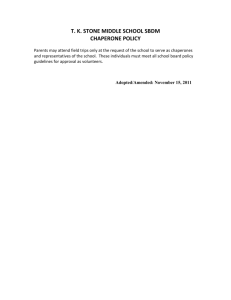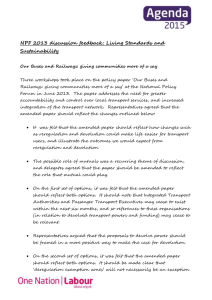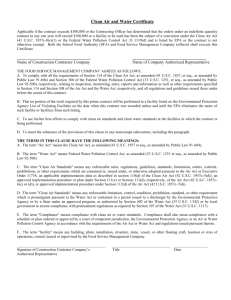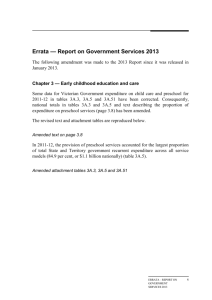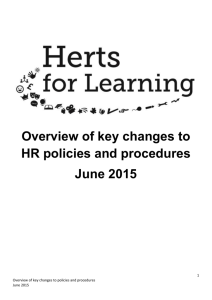enhancing the Fla Workplace Code of Conduct and Compliance
advertisement
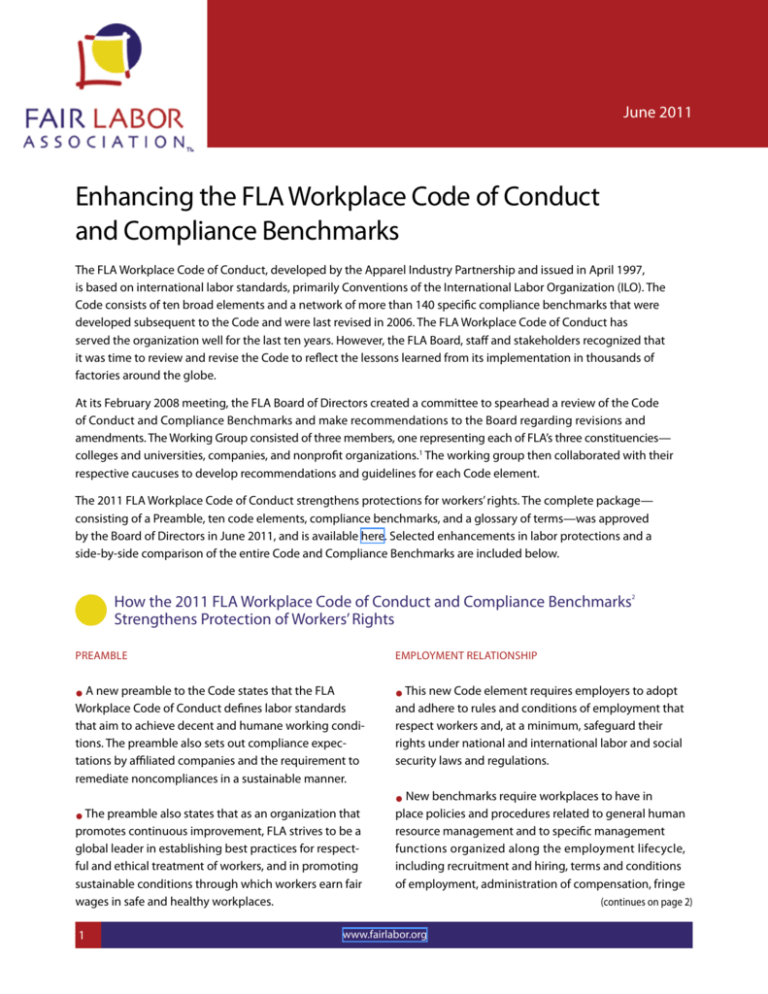
June 2011 Enhancing the FLA Workplace Code of Conduct and Compliance Benchmarks The FLA Workplace Code of Conduct, developed by the Apparel Industry Partnership and issued in April 1997, is based on international labor standards, primarily Conventions of the International Labor Organization (ILO). The Code consists of ten broad elements and a network of more than 140 specific compliance benchmarks that were developed subsequent to the Code and were last revised in 2006. The FLA Workplace Code of Conduct has served the organization well for the last ten years. However, the FLA Board, staff and stakeholders recognized that it was time to review and revise the Code to reflect the lessons learned from its implementation in thousands of factories around the globe. At its February 2008 meeting, the FLA Board of Directors created a committee to spearhead a review of the Code of Conduct and Compliance Benchmarks and make recommendations to the Board regarding revisions and amendments. The Working Group consisted of three members, one representing each of FLA’s three constituencies— colleges and universities, companies, and nonprofit organizations.1 The working group then collaborated with their respective caucuses to develop recommendations and guidelines for each Code element. The 2011 FLA Workplace Code of Conduct strengthens protections for workers’ rights. The complete package— consisting of a Preamble, ten code elements, compliance benchmarks, and a glossary of terms—was approved by the Board of Directors in June 2011, and is available here. Selected enhancements in labor protections and a side-by-side comparison of the entire Code and Compliance Benchmarks are included below. How the 2011 FLA Workplace Code of Conduct and Compliance Benchmarks2 Strengthens Protection of Workers’ Rights Preamble Employment Relationship A new preamble to the Code states that the FLA •Workplace Code of Conduct defines labor standards new Code element requires employers to adopt •andThisadhere to rules and conditions of employment that that aim to achieve decent and humane working conditions. The preamble also sets out compliance expectations by affiliated companies and the requirement to remediate noncompliances in a sustainable manner. respect workers and, at a minimum, safeguard their rights under national and international labor and social security laws and regulations. The preamble also states that as an organization that •promotes continuous improvement, FLA strives to be a global leader in establishing best practices for respectful and ethical treatment of workers, and in promoting sustainable conditions through which workers earn fair wages in safe and healthy workplaces. 1 New benchmarks require workplaces to have in •place policies and procedures related to general human resource management and to specific management functions organized along the employment lifecycle, including recruitment and hiring, terms and conditions of employment, administration of compensation, fringe www.fairlabor.org (continues on page 2) (continued from page 1) Forced Labor benefits and hours of work, industrial relations, work rules and discipline, skills development, health, safety and environmental management, and termination and retrenchment. This Code element categorically bans the use of all •forms of forced labor. Consistent with this enhanced New benchmarks place greater emphasis on recruit•ment and hiring processes, including when employment agencies are used, to ensure better protections for workers. • The new Code emphasizes employment and workplace protections for precarious workers, particularly migrant, contract and contingent workers. rejection of the use of forced labor, a benchmark that allowed prison labor (under certain narrow circumstances) has been eliminated. benchmarks on freedom of movement require •thatNewworkers have free egress from workplaces at all times and clearly state that employment terms shall not confine or restrict employees’ freedom of movement. Child Labor Non-Discrimination benchmarks were amended to make it explicit •that,Several if not provided by law, employers must provide protection to workers who allege discrimination. This Code element sets the minimum age for employ•ment at the higher of 15 years or the age for completion of compulsory education. It eliminates the possibility of employment at age 14 (under certain circumstances) that was contemplated by the 1997 Code. benchmark on medical examinations was amended with the Code element change, minimum •toAclarify •ageConsistent that medical examinations for fitness are limited to for apprenticeship and for vocational training in the fitness requirements of the position held. on gender-based wage discrimination •wasA benchmark amended to cover all forms of compensation discrimination. The benchmark emphasizes equal pay for equal work. Freedom of Association and collective bargaining A new benchmark sets forth that when the right to •freedom of association and collective bargaining Harassment or Abuse new benchmark explicitly bans the use or threat •ofApsychological abuse, such as forcing workers to sign letters of self-criticism or posting names of workers subject to disciplinary measures, as a means to maintain labor discipline. existing benchmark on requirement by employer •toAnensure that the workplace is free from violence, harassment or abuse was amended to make it explicit that, if not provided by law, employers must provide protection to workers who allege harassment or abuse violations. 2 benchmarks is also set at the highest of 15 years or the age for completion of compulsory education. is restricted under law, employers shall not obstruct alternative legal means of worker association. benchmark on the right to strike sets out •thatA revised employers shall not impose any sanction on workers organizing or having participated in a legal strike. Health, Safety and Environment existing code element on health and safety •wasAnexpanded to include the environment. This Code www.fairlabor.org (continues on page 3) (continued from page 2) Compensation element calls on employers to adopt responsible measures to mitigate negative impacts that the workplace has on the environment. This new Code element covers wages, benefits and •overtime compensation. It establishes that every worker As appropriate, former health and safety benchmarks •were also expanded to include environmental issues. For example, a benchmark on evacuation requirements and procedures was expanded to require evacuation emergency plans to include procedures for notifying local community authorities in case of accidental discharge or release of chemical/waste products or any other environmental emergency. new benchmark sets out that workers shall not suf•ferAany negative consequences for refusing to work with has a right to compensation for a regular work week that is sufficient to meet the worker’s basic needs and provide some discretionary income. Employers shall pay at least the minimum wage or the appropriate prevailing wage, whichever is higher; comply with all legal requirements on wages; and provide any fringe benefits required by law or contract. Code element also requires employers, working •withThisFLA, to take appropriate actions that seek to progressively realize a level of compensation that meets basic needs and provides some discretionary income. unguarded or unsafe machinery, equipment or tools. One benchmark was modified and an additional •benchmark added to enhance protection of workers in Glossary of Terms employer-provided dormitories. A new glossary is included to define key terms •referenced in the Code. Hours of Work “Extraordinary business circumstances,” under •which some exceptions in the implementation of the A new Code element sets a limit for regular weekly •hours of work of 48 hours, with at least 24 consecutive hours of rest in every seven-day period and the requirement that all overtime work shall be consensual. It also sets forth that overtime shall not be requested regularly and be compensated at a premium rate. Other than in exceptional circumstances (see below under Glossary of Terms), the sum of regular and overtime hours in a week shall not exceed 60 hours. 1997 Code were permitted, was deleted from the 2011 Code and replaced with the narrower concept of exceptional circumstances. The new definition sets forth that peak production periods, which can be planned for, or holidays or seasonal fluctuations, are not exceptional circumstances. In addition to setting a limit on overtime, •benchmarks require commitment to progressive reduction of overtime. End Notes 1 The members of the Board appointed to the Working Group were Linda Golodner from the NGO Caucus, Carol Kaesebier from the University Caucus, and Gregg Nebel from the Industry Caucus (since renamed Business Caucus). In June 2009, Karen Daubert replaced Kaesebier representing the University Caucus. 3 2 Comparison with 1997 FLA Workplace Code of Conduct and 2006 Compliance Benchmarks. www.fairlabor.org Code of Conduct and Compliance Benchmarks, Side-by-Side Comparison CODE OF CONDUCT 1997 VERSION STATUS NEW 2011 REVISION EMPLOYMENT RELATIONSHIP Employers shall adopt and adhere to rules and conditions of employment that respect workers and, at a minimum, safeguard their rights under national and international labor and social security laws and regulations. NONDISCRIMINATION SAME NONDISCRIMINATION No person shall be subject to any discrimination No person shall be subject to any discrimination in employment, including hiring, salary, benefits, in employment, including hiring, compensation, advancement, discipline, termination or retirement, advancement, discipline, termination or retirement, on the basis of gender, race, religion, age, disability, on the basis of gender, race, religion, age, disability, sexual orientation, nationality, political opinion, or sexual orientation, nationality, political opinion, social social or ethnic origin. group or ethnic origin. HARASSMENT OR ABUSE SAME HARASSMENT OR ABUSE Every employee shall be treated with respect and Every employee shall be treated with respect and dignity. No employee shall be subject to any physical, dignity. No employee shall be subject to any physical, sexual, psychological or verbal harassment or abuse. sexual, psychological or verbal harassment or abuse. FORCED LABOR AMENDED FORCED LABOR There shall not be any use of forced labor, whether There shall be no use of forced labor, including in the form of prison labor, indentured labor, bonded prison labor, indentured labor, bonded labor or other labor or otherwise. forms of forced labor. CHILD LABOR AMENDED CHILD LABOR No person shall be employed at an age younger than No person shall be employed under the age of 15 or 15 (or 14 where the law of the country of manufac- under the age for completion of compulsory educa- ture allows*) or younger than the age for completing tion, whichever is higher. compulsory education in the country of manufacture where such age is higher than 15. FREEDOM OF ASSOCIATION AND SAME FREEDOM OF ASSOCIATION AND COLLECTIVE BARGAINING COLLECTIVE BARGAINING Employers shall recognize and respect the right of Employers shall recognize and respect the right of employees to freedom of association and collective employees to freedom of association and collective bargaining. bargaining. 4 5 www.fairlabor.org CODE OF CONDUCT 1997 VERSION STATUS HEALTH AND SAFETY AMENDED 2011 REVISION HEALTH, SAFETY, AND ENVIRONMENT Employers shall provide a safe and healthy working Employers shall provide a safe and healthy work- environment to prevent accidents and injury to health place setting to prevent accidents and injury to arising out of, linked with, or occurring in the course health arising out of, linked with, or occurring in the of work or as a result of the operation of employer course of work or as a result of the operation of facilities. employers’ facilities. Employers shall adopt responsible measures to mitigate negative impacts that the workplace has on the environment. HOURS OF WORK AMENDED HOURS OF WORK Except in extraordinary business circumstances, Employers shall not require workers to work more employees shall (i) not be required to work more than than the regular and overtime hours allowed by the the lesser of (a) 48 hours per week and 12 hours law of the country where the workers are employed. overtime or (b) the limits on regular and overtime The regular work week shall not exceed 48 hours. hours allowed by the law of the country of manufac- Employers shall allow workers at least 24 con- ture or, where the laws of such country do not limit secutive hours of rest in every seven-day period. All the hours of work, the regular work week in such overtime work shall be consensual. country plus 12 hours overtime and (ii) be entitled to at least one day off in every seven day period. Employers shall not request overtime on a regular basis and shall compensate all overtime work at a premium rate. Other than in exceptional circumstances, the sum of regular and overtime hours in a week shall not exceed 60 hours. WAGES AND BENEFITS AMENDED COMPENSATION Employers recognize that wages are essential to Every worker has a right to compensation for a regu- meeting employees’ basic needs. Employers shall lar work week that is sufficient to meet the worker’s pay employees, as a floor, at least the minimum basic needs and provide some discretionary income. wage required by local law or the prevailing industry Employers shall pay at least the minimum wage or wage, whichever is higher, and shall provide legally the appropriate prevailing wage, whichever is higher, mandated benefits. comply with all legal requirements on wages, and provide any fringe benefits required by law or contract. Where compensation does not meet workers’ basic needs and provide some discretionary income, each employer shall work with the FLA to take appropriate actions that seek to progressively realize a level of compensation that does. 5 www.fairlabor.org CODE OF CONDUCT 1997 VERSION STATUS OVERTIME COMPENSATION moved 2011 REVISION Hours of Work and Overtime Compensation In addition to their compensation for regular hours of standards are combined under the revised Hours of work, employees shall be compensated for overtime Work Code. hours at such premium rate as is legally required in the country of manufacture or, in those countries where such laws do not exist, at a rate at least equal to their regular hourly compensation rate. Compliance Benchmarks STATUS 2006 VERSION 2011 REVISION REVISED BENCHMARK TITLE EMPLOYMENT RELATIONSHIP (ER) Amended F.9 ER.1 General/Human Resource Management Systems Amended WBOT.23 ER.2 General/Documentation and Inspection Amended D.2, D.3 ER.3 Recruitment and Hiring/Employment Decisions Amended CL.3, CL.4 ER.4 Recruitment and Hiring/Proof of Age Documentation New ER.5 Recruitment and Hiring/Employment Agency Recruitment Practices New ER.6 Recruitment and Hiring/Employers Agreement with Employment Agencies New ER.7 Recruitment and Hiring/General Principles on the Use of Contract, Contingent or Temporary Workers New ER.8 Recruitment and Hiring/Conditions of Hiring Contract or Temporary Workers New ER.9 Recruitment and Hiring/Invalid Use of Contract, Contingent or Temporary Workers ER.10 Terms and Conditions/Employment Terms New ER.11 Terms and Conditions/Contract, Contingent or Temporary Workers New ER.12 Terms and Conditions/Contract, Contingent or Temporary Worker to Permanent Employee New ER.13 Terms and Conditions/Apprenticeship New ER.14 Terms and Conditions/Other Special Categories of Workers New ER.15 Terms and Conditions/New Employee Orientation ER.16 Terms and Conditions/Communication ER.17 Terms and Conditions/Supervisor Training Amended Amended New F.3, F.4 H&S.6, WBOT.23 (Employment Relationship (ER) continues on page 7) 6 www.fairlabor.org Compliance Benchmarks STATUS 2006 VERSION 2011 REVISION REVISED BENCHMARK TITLE EMPLOYMENT RELATIONSHIP (ER) (continued from page 6) Amended WBOT.4, WBOT.17 ER.18 Administration of Compensation/Timing and Completeness ER.19 Administration of Compensation/Termination Payouts F.6 ER.20 Administration of Compensation/Wage Advances Amended F.7, WBOT.28 ER.21 Administration of Compensation/Free Disposal of Wages Amended WBOT.5 ER.22 Administration of Fringe Benefits/Holidays, Leave, Legal Social Benefits and Bonuses Amended HOW.6 ER.23 Administration of Hours/Time Recording System Amended WBOT.6 ER.24 Administration of Hours/Production and Incentive Schemes Amended FOA.26 ER.25 Industrial Relations New FOA.15 ER.26 Industrial Relations/Right to Organize, Bargain and Participate in Legal Strikes Amended H&A.2, H&A.3, H&A.4, H&A.5, H&A.6, H&A.7 ER.27 Work Rules and Discipline New ER.28 Skills Development/Training New ER.29 Skills Development/Management of Performance Reviews New ER.30 Skills Development/Promotion, Demotion and Job Reassignment ER.31 Health, Safety, and Environmental Management System/Policies and Procedures ER.32 Termination and Retrenchment/General Policies and Procedures New Amended H&S.3, H&S.5 New NONDISCRIMINATION (ND) D.1 ND.1 General Compliance Nondiscrimination Amended D.3 ND.2 Recruitment and Employment Practices/Job Advertisements, Job Descriptions and Evaluation Policies Amended D.4 ND.3 Compensation Discrimination Amended D.5 ND.4 Marital Discrimination Amended D.6 ND.5 Pregnancy Testing Amended D.7 ND.6 Marriage or Pregnancy Discrimination Amended D.8 ND.7 Pregnancy and Employment Status Amended D.9 ND.8 Protection and Accommodation of Pregnant Workers and New Mothers Amended D.10 ND.9 Health-Related Discrimination (Nondiscrimination (ND) continues on page 8) 7 www.fairlabor.org Compliance Benchmarks STATUS 2006 VERSION 2011 REVISION REVISED BENCHMARK TITLE NONDISCRIMINATION (ND) (continued from page 7) Amended D.11 ND.10 Medical Examination Amended D.12 ND.11 Confidentiality of Health Status Amended D.13 ND.12 Reasonable Accommodation for Health Reasons Removed D.14 HARASSMENT OR ABUSE (H/A) Amended H&A.1 H/A.1 General Compliance Harassment or Abuse H&A.8 H/A.2 Discipline/Monetary Fines and Penalties H&A.9 H/A.3 Discipline/Access to Facilities H&A.10 H/A.4 Discipline/Physical Abuse H&A.11 H/A.5 Discipline/Verbal Abuse H/A.6 Discipline/Psychological Abuse New Amended H&A.12 H/A.7 Discipline/Freedom of Movement Amended H&A.13 H/A.8 Violence/Harassment or Abuse Amended H&A.14 H/A.9 Sexual Harassment Amended H&A.15 H/A.10 Security Practices/Body Searches Amended H&A.16 H/A.11 Punishment of Abusive Workers/Supervisors/Managers/Workers FORCED LABOR (F) Amended F.1 F.1 General Compliance Forced Labor F.2 F.2 F.5 F.3 Debt/Bonded Labor Removed F.8 Amended F.10 F.4 Freedom of Movement Amended F.11 F.5 Employer Controlled Residence F.12 F.6 Freedom of Movement/Employer Controlled Residence F.13 F.7 Freedom of Movement/Workers Ability to Terminate Amended F.14 F.8 Forced Overtime Amended F.15 F.9 Personal Workers Identification and Other Documents Amended F.16 F.10 Storage for Employee Documents Removed F.17 8 www.fairlabor.org Compliance Benchmarks STATUS 2006 VERSION 2011 REVISION REVISED BENCHMARK TITLE CHILD LABOR (CL) CL.1 CL.1 General Compliance Child Labor CL.2 CL.2 Child Labor CL.5 CL.3 Government Permits and Parental Consent Documentation CL.6 CL.4 Employment of Young Workers CL.7 CL.5 Hazardous Work for Young Workers CL.6 CL.6 Amended CL.9 CL.7 Apprenticeships and Vocational Training/Minimum Working Age Amended CL.10 CL.8 Apprenticeships and Vocational Training/Legal Compliance Amended FREEDOM OF ASSOCIATION AND COLLECTIVE BARGAINING (FOA) FOA.1 FOA.1 General Compliance Freedom of Association FOA.2 FOA.2 Right to Freely Associate FOA.3 Legal Restriction/Alternative Means FOA.10 FOA.4 Anti-Union Violence/Harassment or Abuse FOA.12 FOA.5 Anti-Union Discrimination/Dismissal, Other Loss of Rights, and Blacklisting FOA.27 FOA.6 Restoration of Workers Rights/Reinstatement Amended FOA.13 FOA.7 Protection of Union Representatives Amended FOA.9 FOA.8 Production Shift/Workplace Closure FOA.14 FOA.9 Severance Pay FOA.3 FOA.10 Employer Interference FOA.5 FOA.11 Employer Interference/Constitution, Elections, Administration, Activities and Programs FOA.6 FOA.12 Employer Interference/Registration FOA.7, FOA.8 FOA.13 Employer Interference/Favoritism FOA.11 FOA.14 Employer Interference/Police and Military Forces FOA.25 FOA.15 Facilities for Worker Representatives FOA.18, FOA.19 FOA.16 Right to Collective Bargaining/Good Faith FOA.20 FOA.17 Right to Collective Bargaining/Exclusive Bargaining and Other Recognized Unions FOA.21 FOA.18 Right to Collective Bargaining/Unorganized Workers Amended New Amended Amended Amended Amended (Freedom of Association and Collective Bargaining (FOA) continues on page 10) 9 www.fairlabor.org Compliance Benchmarks STATUS 2006 VERSION 2011 REVISION REVISED BENCHMARK TITLE FREEDOM OF ASSOCIATION AND COLLECTIVE BARGAINING (FOA) (continued from page 9) FOA.22 FOA.19 Right to Collective Bargaining/Compliance with Collective Bargaining Agreement FOA.23 FOA.20 Right to Collective Bargaining/Validity of Collective Bargaining Agreement FOA.24 FOA.21 Rights of Minority Unions and their Members FOA.16 FOA.22 Right to Strike/Sanction for Organizing or Participating in Legal Strikes FOA.17 FOA.23 Right to Strike/Replacement Workers FOA.4 FOA.24 Deduction of Union Dues and Other Fees HEALTH, SAFETY, AND ENVIRONMENT (HSE) Amended H&S.1 HSE.1 General Compliance Health, Safety, and Environment Amended H&S.2 HSE.2 Document Maintenance/Workers Accessibility and Awareness Amended H&S.7 HSE.3 Notification and Record Maintenance Amended H&S.8 HSE.4 Permits and Certificates Amended H&S.9 HSE.5 Evacuation Requirements and Procedure Amended H&S.10 HSE.6 Safety Equipment and First Aid Training Amended H&S.11 HSE.7 Personal Protective Equipment Amended H&S.12 HSE.8 Use of Personal Protective Equipment Amended H&S.13 HSE.9 Chemical Management and Training Amended H&S.14 HSE.10 Material Safety Data Sheets/Workers Access and Awareness Amended H&S.15 HSE.11 Chemical Management/Pregnant Women and Young Workers Amended H&S.16 HSE.12 Protection Reproductive Health Amended H&S.17 HSE.13 Ventilation/Electrical/Facility Installation and Maintenance Amended H&S.18 HSE.14 Machinery Safety, Maintenance and Workers Training Amended H&S.19 HSE.15 Proper Use of Machinery Amended H&S.19 HSE.16 Workers Refusal to Use Unguarded or Unsafe Machinery Amended H&S.20 HSE.17 Ergonomics Amended H&S.21 HSE.18 Medical Facilities Amended H&S.22 HSE.19 Sanitation in Workplace Facilities Amended H&S.23 HSE.20 Toilets (Health, Safety, and Environment (HSE) continues on page 11) 10 www.fairlabor.org Compliance Benchmarks STATUS 2006 VERSION 2011 REVISION REVISED BENCHMARK TITLE HEALTH, SAFETY, AND ENVIRONMENT (HSE) (continued from page 10) Amended H&S.24 HSE.21 Toilets/Restrictions Amended H&S.25 HSE.22 Food Preparation Amended H&S.26 HSE.23 Drinking Water Amended H&S.27 HSE.24 Drinking Water/Restrictions Amended H&S.28 HSE.25 Dormitory Facilities HSE.26 Dormitories Separate From Production Facilities HSE.27 Childcare Facilities/Children on Premises New CL.11, CL.12 HOURS OF WORK (HOW) Amended HOW.1 HOW.1 General Compliance Hours of Work Amended HOW.2 HOW.2 Rest Day HOW.3 HOW.3 Meal and Rest Breaks HOW.4 HOW.4 Protected Workers (Women and Young Workers)/Regulations on Hours of Work HOW.5 HOW.5 Protected Workers (Women and Young Workers)/Record Keeping HOW.7 HOW.6 Maintenance of Reasonable Levels of Staff Amended HOW.10 HOW.7 Overtime/Calculation over Period Longer than One Week Amended HOW.8, HOW.11 HOW.8 Forced Overtime/Exceptional Circumstances Amended HOW.12 HOW.9 Exceptional Circumstance/Overtime Explanation HOW.13 HOW.10 Public Holidays HOW.14 HOW.11 Annual Leave HOW.15 HOW.12 Annual Leave/Determination HOW.16 HOW.13 Annual Leave/Restrictions HOW.18 HOW.14 Annual Leave/Wage Payments HOW.17 HOW.15 Leave/Retaliation HOW.19 HOW.16 Sick Leave HOW.20 HOW.17 Sick Leave/Restrictions HOW.21 HOW.18 Calculation of Absences HOW.22 HOW.19 Suspension of Work Amended Amended 11 www.fairlabor.org Compliance Benchmarks STATUS 2006 VERSION 2011 REVISION REVISED BENCHMARK TITLE COMPENSATION (C) Amended WBOT.1 C.1 General Compliance Compensation Amended WBOT.2 C.2 Minimum Wage Amended WBOT.3 C.3 Training and Probation Wage Amended WBOT.4 C.4 Timely Payment of Wages Amended WBOT.17 C.5 Accurate Calculation, Recording, and Payment of Wage Amended WBOT.18 C.6 Accurate Length of Service Calculation Amended WBOT. 6, WBOT. 7, WBOT. 8, WBOT.10, WBOT.12 C.7 Calculation Basis for Overtime Payments Amended WBOT.11 C.8 Overtime Wage Awareness WBOT.9 C.9 Nonpayment of Incentives WBOT.13 C.10 Deposit of Legally Mandated Deductions WBOT.14 C.11 Voluntary Wage Deductions WBOT.15 C.12 Voluntary Wage Deduction/Workers Access to Information WBOT.26 C.13 Pay Statement WBOT.27 C.14 Compensation Receipt WBOT.21 C.15 Record Maintenance WBOT.19 C.16 False Payroll Records Amended HOW.9, WBOT.22, WBOT.24 C.17 Workers Awareness and Understanding of Compensation Amended WBOT.16 C.18 Employer Provided Fringe Benefits Amended WBOT.24 C.19 Compensation Disputes Amended New 12 GLOSSARY OF TERMS www.fairlabor.org


